Pseudopotential Lattice Boltzmann Method Simulation of Boiling Heat Transfer at Different Reduced Temperatures
Abstract
1. Introduction
- Microlayer evaporation underneath a bubble.
- Transient conduction in overheated liquid.
- Convective transport caused through bubble motion.
- Surface rewetting and bubble pumping effect.
2. Numerical Model
2.1. Hydrodynamic Sub-Model
2.2. Thermal Sub-Model
2.3. Boundary Conditions
2.4. Initial Conditions
3. Results and Discussion
3.1. Simulation of a Bubble Cycle Using Literature Data
3.2. Simulation of the Boiling Curve Using Literature Data for Different Reduced Temperatures
3.2.1. Influence of Liquid Wettability
3.2.2. Influence of the Surface Tension
3.2.3. Influence of the Gravitational Acceleration
4. Conclusions
Author Contributions
Funding
Data Availability Statement
Acknowledgments
Conflicts of Interest
Abbreviations
| CFD | Computational Fluid Dynamics |
| CHF | Critical Heat Flux |
| CSF | Continuum Surface Force |
| DSMC | Direct Simulation Monte Carlo |
| LBM | Lattice Boltzmann Method |
| LS | Level Set |
| MD | Molecular Dynamics |
| MRT | Multi-Relaxation Time |
| ONB | Onset of Nucleate Boiling |
| VOF | Volume of Fluid |
References
- Ishii, M.; Hibiki, T. Thermo-Fluid Dynamics of Two-Phase Flow, 2nd ed.; Springer: New York, NY, USA, 2011; pp. 1–518. [Google Scholar]
- Prosperetti, A.; Tryggvason, G. (Eds.) Computational Methods for Multiphase Flow; Cambridge University Press: Cambridge, UK, 2007; pp. 1–470. [Google Scholar]
- Carey, V.P. Liquid-Vapor Phase-Change Phenomena: An Introduction to the Thermophysics of Vaporization and Condensation Processes in Heat Transfer Equipment; CRC Press: Boca Raton, FL, USA, 2020; pp. 1–730. [Google Scholar]
- Nukiyama, S. Maximum and minimum values of heat q transmitted from metal to boiling water under atmospheric pressure. J. Soc. Mech. Eng. Jpn. 1934, 37, 367–374. [Google Scholar] [CrossRef]
- Alvariño, P.F.; Simón, M.L.S.; Guzella, M.S.; Paz, J.M.A.; Jabardo, J.M.S.; Cabezas-Gómez, L. Nucleate boiling. Experimental investigation of the CHF of HFE-7100 under pool boiling conditions on differently roughened surfaces. Int. J. Heat Mass Transf. 2019, 139, 269–279. [Google Scholar] [CrossRef]
- Sajjad, U.; Hussain, I.; Wang, C. A high-fidelity approach to correlate the nucleate pool boiling data of roughened surfaces. Int. J. Multiph. Flow 2021, 142, 103719. [Google Scholar] [CrossRef]
- Martins, I.T.; Alvariño, P.F.; Cabezas-Gómez, L. A new methodology for experimental analysis of single-cavity bubble’s nucleation, growth and detachment in saturated HFE-7100. Exp. Therm. Fluid Sci. 2024, 159, 111272. [Google Scholar]
- Ferziger, J.H.; Perić, M. Computational Methods for Fluid Dynamics; Springer: Berlin/Heidelberg, Germany, 2002; pp. 1–426. [Google Scholar]
- Tryggvason, G.; Scardovelli, R.; Zaleski, S. Direct Numerical Simulations of Gas–Liquid Multiphase Flows; Cambridge University Press: Cambridge, UK, 2011; pp. 1–324. [Google Scholar]
- Brackbill, J.U.; Kothe, D.B.; Zemach, C. Continuum Method for Modeling Surface Tension. J. Comput. Phys. 1993, 108, 175–194. [Google Scholar] [CrossRef]
- Krüger, T.; Kusumaatmaja, H.; Kuzmin, A.; Shardt, O.; Silva, G.; Viggen, E.M. The Lattice Boltzmann Method—Principles and Practice, 1st ed.; Springer: Berlin/Heidelberg, Germany, 2017; p. 694. [Google Scholar]
- Guo, Z.; Shu, C. Lattice Boltzmann Method and its Applications in Engineering, 1st ed.; World Scientific Publishing Co. Pte. Ltd.: Singapore, 2013; p. 419. [Google Scholar]
- Succi, S. The Lattice Boltzmann Equation for Fluid Dynamics and Beyond; Oxford University Press: Oxford, UK, 2001; pp. 1–308. [Google Scholar]
- Czelusniak, L.E.; Mapelli, V.P.; Guzella, M.S. Force approach for the pseudopotential lattice Boltzmann method. Phys. Rev. E 2020, 102, 033307. [Google Scholar]
- Guzella, M.S.; Czelusniak, L.E.; Mapelli, V.P.; Alvariño, P.A.; Ribatski, G.; Cabezas-Gómez, L. Simulation of Boiling Heat Transfer at Different Reduced Temperatures with an Improved Pseudopotential Lattice Boltzmann Method. Symmetry 2020, 12, 1358. [Google Scholar] [CrossRef]
- Jaramillo, A.; Mapelli, V.P.; Cabezas-Gómez, L. Pseudopotential Lattice Boltzmann Method for boiling heat transfer: A mesh refinement procedure. Appl. Therm. Eng. 2022, 213, 118705. [Google Scholar]
- Shan, X.; Chen, H. Lattice Boltzmann model for simulating flows with multiple phases and components. Phys. Rev. E 1993, 47, 1815–1820. [Google Scholar]
- Shan, X.; Chen, H. Simulation of nonideal gases and liquid-gas phase transitions by the lattice Boltzmann equation. Phys. Rev. E 1994, 49, 2941–2948. [Google Scholar]
- Li, Q.; Kang, Q.J.; Francois, M.M.; He, Y.L.; Luo, K.H. Lattice Boltzmann modeling of boiling heat transfer: The boiling curve and the effects of wettability model: Methods and applications. Int. J. Heat Mass Transf. 2015, 85, 787–796. [Google Scholar] [CrossRef]
- Li, Q.; Zhou, P.; Yan, H.J. Improved thermal lattice Boltzmann model for simulation of liquid-vapor phase change. Phys. Rev. E 2017, 96, 063303. [Google Scholar] [CrossRef] [PubMed]
- Huang, H.B.; Krafczyk, M.; Lu, X. Forcing term in single-phase and Shan-Chen-type multiphase lattice Boltzmann models. Phys. Rev. E 2011, 84, 046710. [Google Scholar] [CrossRef]
- Shan, X. Analysis and reduction of the spurious current in a class of multiphase lattice Boltzmann models. Phys. Rev. E 2006, 73, 047701. [Google Scholar] [CrossRef]
- Shan, X. Pressure tensor calculation in a class of nonideal gas lattice Boltzmann models. Phys. Rev. E 2008, 77, 066702. [Google Scholar] [CrossRef] [PubMed]
- Li, Q.; Luo, K.H.; Kang, Q.J.; Chen, Q.; Liu, Q. Lattice Boltzmann methods for multiphase flow and phase-change heat transfer. Prog. Energy Combust. Sci. 2016, 9, 62–105. [Google Scholar] [CrossRef]
- Mu, Y.T.; Chen, L.; He, Y.L.; Kang, Q.J.; Tao, W.Q. Nucleate boiling performance evaluation of cavities at mesoscale level. J. Heat Mass Transf. 2017, 106, 708–719. [Google Scholar] [CrossRef]
- Gong, S.; Cheng, P. Nucleate boiling. Direct numerical simulations of pool boiling curves including heater’s thermal responses and the effect of vapor phase’s thermal conductivity. Int. Commun. Heat Mass Transf. 1963, 87, 61–71. [Google Scholar] [CrossRef]
- Fogliatto, E.O.; Clausse, A.; Teruel, F.E. Evelopment of a double-mrt pseudopotential model for tridimensional boiling simulation. Int. J. Therm. Sci. 2022, 179, 107637. [Google Scholar] [CrossRef]
- Liang, H.; Liu, W.; Li, Y.; Wei, Y. A thermal lattice Boltzmann model for evaporating multiphase flows. Phys. Fluids 2024, 36, 032101. [Google Scholar] [CrossRef]
- Zhang, C.; Chen, L.; Ji, W.; Liu, Y.; Liu, L.; Tao, W.Q. Lattice boltzmann mesoscopic modeling of flow boiling heat transfer processes in a microchannel. Appl. Therm. Eng. 2021, 197, 117369. [Google Scholar] [CrossRef]
- Song, Y.; Mu, X.; Wang, J.; Shen, S.; Liang, G. Channel flow boiling on hybrid wettability surface with lattice boltzmann method. Appl. Therm. Eng. 2021, 233, 121191. [Google Scholar]
- Li, J.; Le, D.V.; Li, H.; Zhang, X.; Kang, C.W.; Lou, J. Hybrid outflow boundary condition for the pseudopotential lbm simulation of flow boiling. Int. J. Therm. Sci. 2024, 196, 108741. [Google Scholar]
- Sayyari, M.J.; Ahmadian, M.H.; Kim, K.C. Three-dimensional condensation in a vertical channel filled with metal foam using a pseudopotential lattice boltzmann model. Int. J. Therm. Sci. 2024, 172, 107352. [Google Scholar]
- Peng, H.; Zhang, J.; He, X.; Wang, Y. Thermal pseudo-potential lattice boltzmann method for simulating cavitation bubbles collapse near a rigid boundary. Comput. Fluids 2024, 217, 104817. [Google Scholar]
- Zhang, R.; Chen, H. Lattice Boltzmann method for simulations of liquid-vapor thermal flows. Phys. Rev. E 2003, 67, 066711. [Google Scholar]
- Hazi, G.; Markus, A. On the bubble departure diameter and release frequency based on numerical simulation results. Int. J. Heat Mass Transf. 2009, 52, 1472–1480. [Google Scholar]
- Gong, S.; Cheng, P. A lattice Boltzmann method for simulation of liquid-vapor phase-change heat transfer. Int. J. Heat Mass Transf. 2012, 55, 4923–4927. [Google Scholar] [CrossRef]
- Gong, S.; Cheng, P. Lattice Boltzmann simulations for surface wettability effects in saturated pool boiling heat transfer. Int. J. Heat Mass Transf. 2015, 85, 635–646. [Google Scholar]
- Gong, S.; Cheng, P. Numerical simulation of pool boiling heat transfer on smooth surfaces with mixed wettability by lattice Boltzmann method. Int. J. Heat Mass Transf. 2015, 80, 206–216. [Google Scholar]
- Taleghani, A.S.; Noori, M.S. Numerical investigation of coalescence phenomena, affected by surface acoustic waves. Eur. Phys. J. Plus 2022, 137, 975. [Google Scholar]
- Noori, M.S.; Taleghani, A.S. Numerical investigation of two-phase flow control based on the coalescence under variation of gravity conditions. Eur. Phys. J. Plus 2024, 139, 1–13. [Google Scholar]
- Schukmann, A.; Hass, V.; Schneider, A. Spurious Aeroacoustic Emissions in Lattice Boltzmann Simulations on Non-Uniform Grids. Fluids 2025, 10, 31. [Google Scholar] [CrossRef]
- Li, Q.; Luo, K.H.; Li, X.J. Lattice Boltzmann modeling of multiphase flows at large density ration with an improved pseudopotential model. Phys. Rev. E 2013, 87, 053301. [Google Scholar]
- Li, Q.; Luo, K.H. Achieving tunable surface tension in the pseudopotential lattice Boltzmann modeling of multiphase flows. Phys. Rev. E 2013, 88, 053307. [Google Scholar]
- Lallem, P.; Luo, L. Theory of the lattice Boltzmann method: Dispersion, dissipation, isotropy, Galilean invariance, and stability. Phys. Rev. E 2000, 61, 6546. [Google Scholar]
- Yuan, P.; Schaefer, L. Equations of state in a lattice Boltzmann model. Phys. Fluids 2006, 18, 101–112. [Google Scholar]
- Chen, L.; Kang, Q.; Mu, Y.; He, Y.; Tao, W. A critical review of the pseudopotential multiphase lattice Boltzmann model: Methods and applications. Int. J. Heat Mass Transf. 2014, 76, 210–236. [Google Scholar] [CrossRef]
- Lee, T.; Lin, C. A stable discretization of the lattice Boltzmann equation for simulation of incompressible two-phase flows at high density ratio. J. Comput. Phys. 2005, 1, 16–47. [Google Scholar]
- Ginzbourg, I.; Adler, P. Boundary flow condition analysis for the three-dimensional lattice Boltzmann model. J. Phys. II 1994, 4, 191–214. [Google Scholar]
- Zou, Q.; He, X. On pressure and velocity boundary conditions for the lattice Boltzmann BGK model. Phys. Fluids 1997, 9, 1591–1598. [Google Scholar]
- Caiazzo, A. Analysis of lattice Boltzmann initialization routines. J. Stat. Phys. 2005, 121, 37–48. [Google Scholar]
- Mei, R.; Luo, L.; Lallem, P.; d’Humieres, D. Consistent initial conditions for lattice Boltzmann simulations. J. Stat. Phys. 2006, 35, 855–862. [Google Scholar]
- Gong, S.; Cheng, P. Lattice Boltzmann simulation of periodic bubble nucleation, growth and departure from a heated surface in pool boiling. Int. Heat Mass Transf. 2013, 64, 122–132. [Google Scholar]
- Son, G.; Dhir, V.K. Dynamics and Heat Transfer Associated with a Single Bubble During Nucleate Boiling on a Horizontal Surface. J. Heat Transf. 1999, 64, 623–631. [Google Scholar] [CrossRef]
- Fritz, W. Maximum volume of vapour bubbles. Phys. Zeitschr 1935, 36, 379–384. [Google Scholar]
- Zuber, N. Nucleate boiling. The region of isolated bubbles and the similarity with natural convection. Int. J. Heat Mass Transf. 1963, 6, 53–78. [Google Scholar] [CrossRef]
- Zuber, N. Nucleate boiling. On the stability of boiling heat transfer. Trans. ASME 1958, 80, 711–720. [Google Scholar]
- Kim, S.H.; Lee, G.C.; Kang, J.Y.; Moriyama, K.; Park, H.S.; Kim, M.H. The role of surface energy in heterogeneous bubble growth on ideal surface. Int. J. Heat Mass Transf. 2017, 108, 1901–1909. [Google Scholar] [CrossRef]
- Bourdon, B.; Bertr, E.; Di Marco, P.; Marengo, M.; Rioboo, R.; De Coninck, J. Wettability influence on the onset temperature of pool boiling: Experimental evidence onto ultra-smooth surfaces. Adv. Colloid Interface Sci. 2015, 221, 34–40. [Google Scholar]
- Hsu, H.; Lin, M.; Popovic, B.; Lin, C.; Patankar, N.A. A numerical investigation of the effect of surface wettability on the boiling curve. PLoS ONE 2017, 12, 0187175. [Google Scholar] [CrossRef] [PubMed]
- Elghanam, R.I.; Fawal, M.M.E.L.; Aziz, R.A.; Skr, M.H.; Khalifa, A.H. Experimental study of nucleate boiling heat transfer enhancement by using surfactant. Ain Shams Eng. J. 2011, 2, 195–209. [Google Scholar]
- Raj, R.; Kim, J.; McQuillen, J. Gravity Scaling Parameter for Pool Boiling Heat Transfer. J. Heat Transf. 2010, 132, 091502. [Google Scholar]
- Colin, C.; Kannengieser, O.; Bergez, W.; Lebon, M.; Sebilleau, J.; Sagan, M.; Tanguy, S. Nucleate pool boiling in microgravity: Recent progress and future prospects. Comptes Rendus Mec. 2017, 345, 21–34. [Google Scholar]

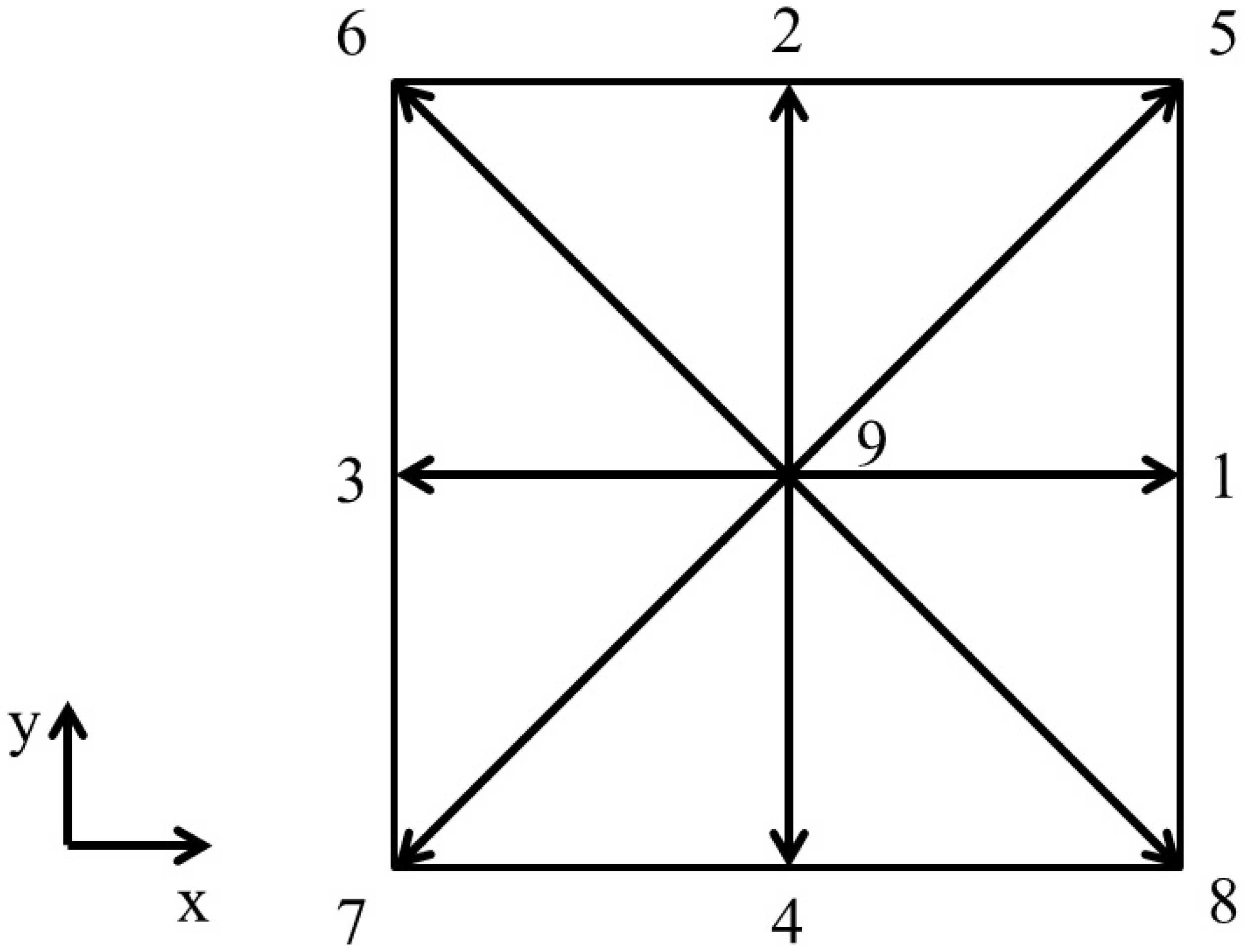

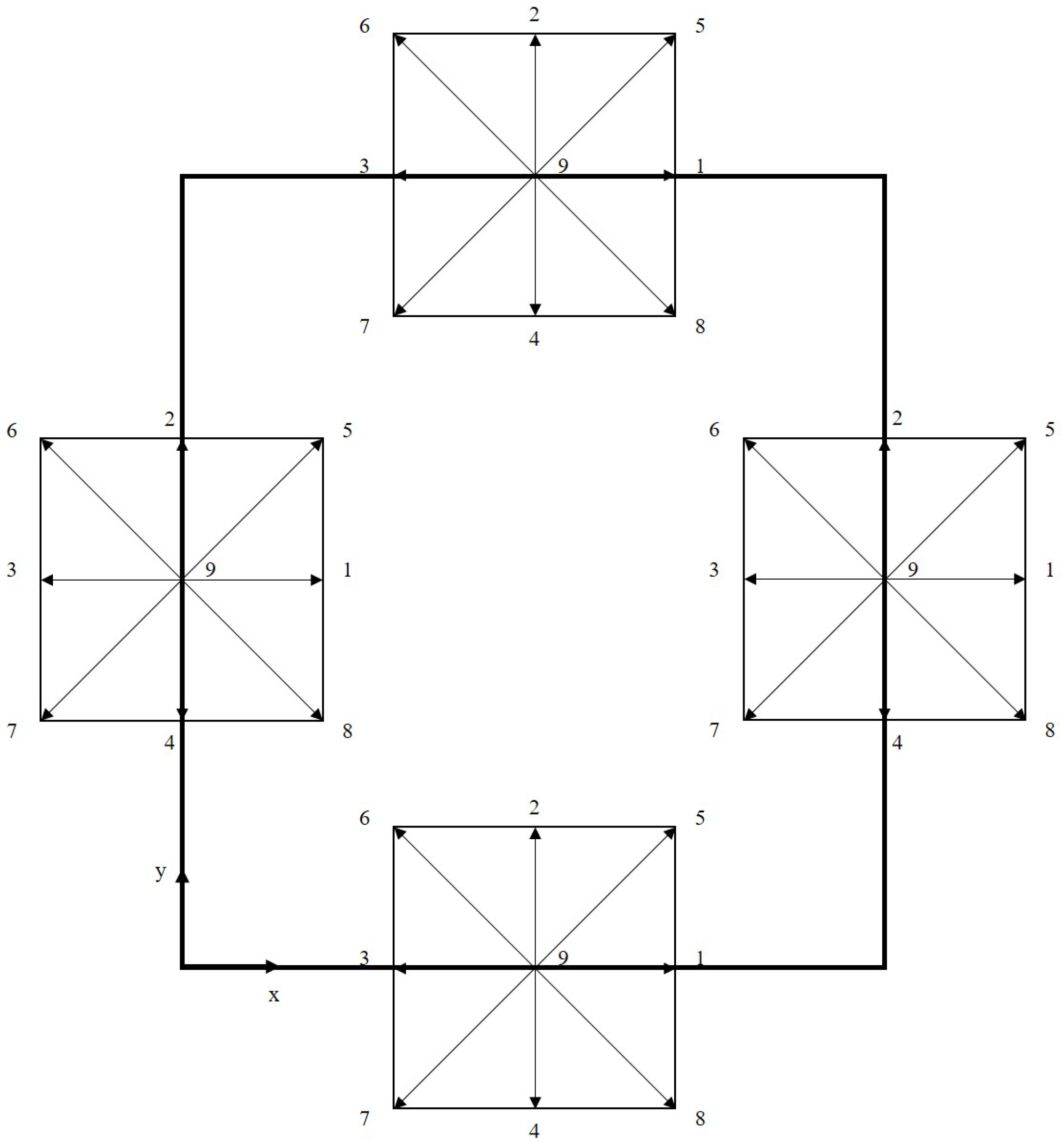

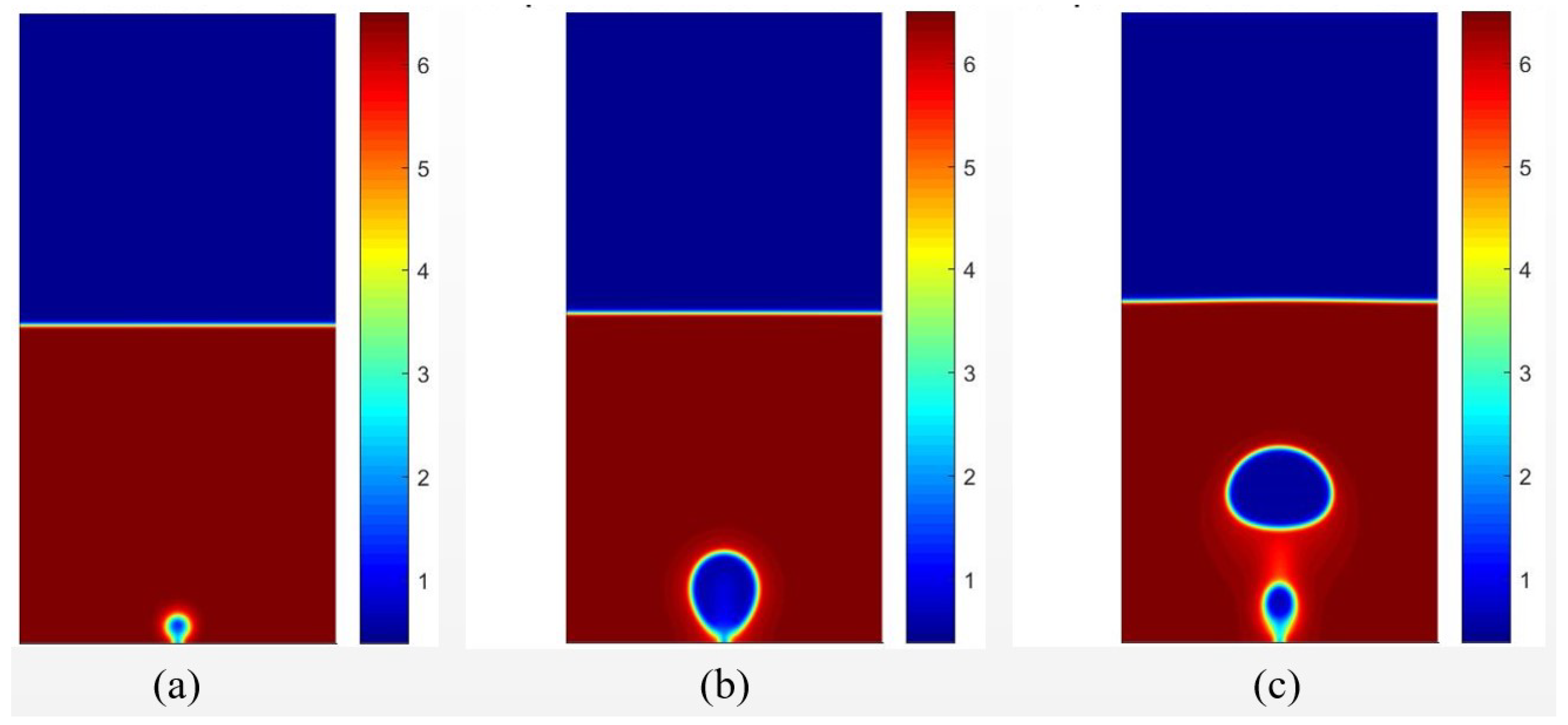
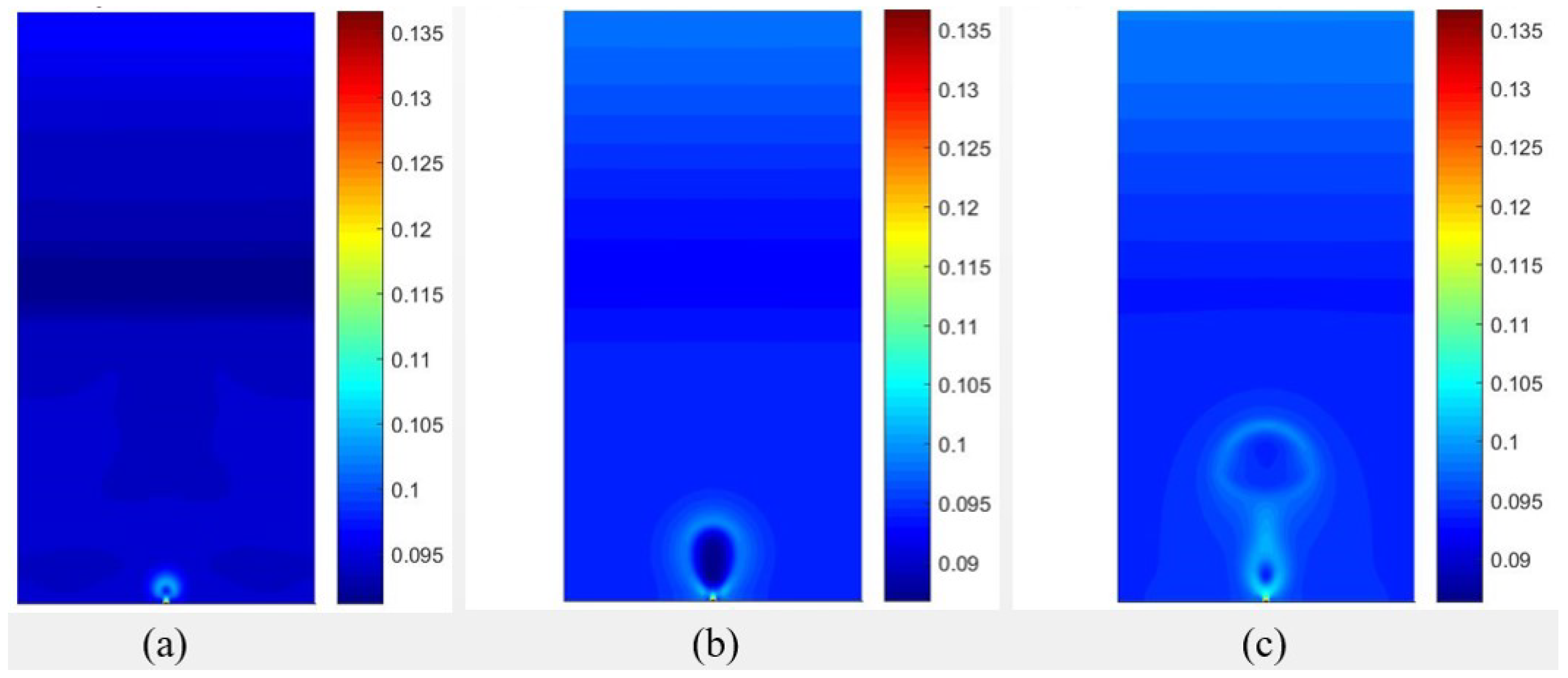




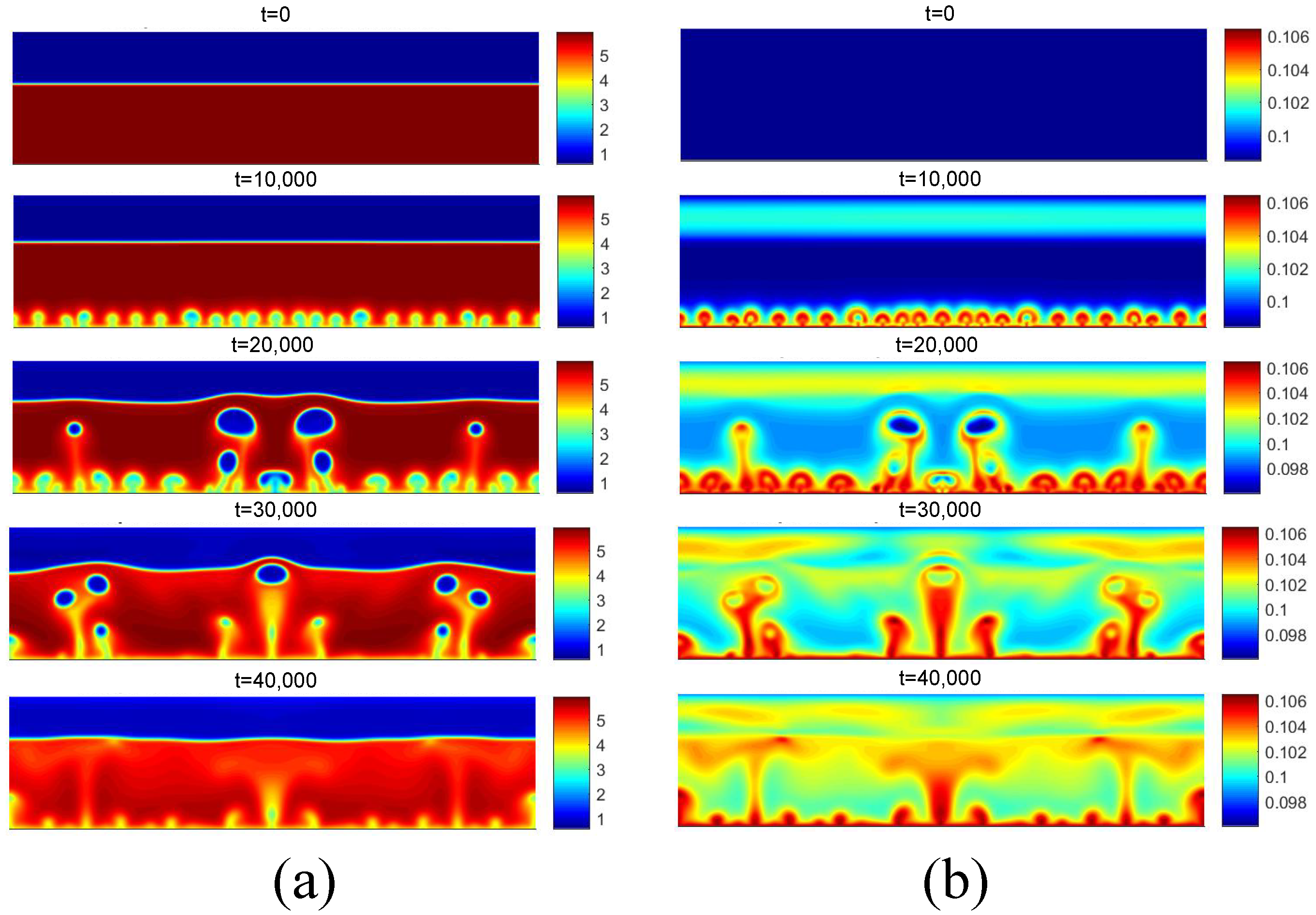




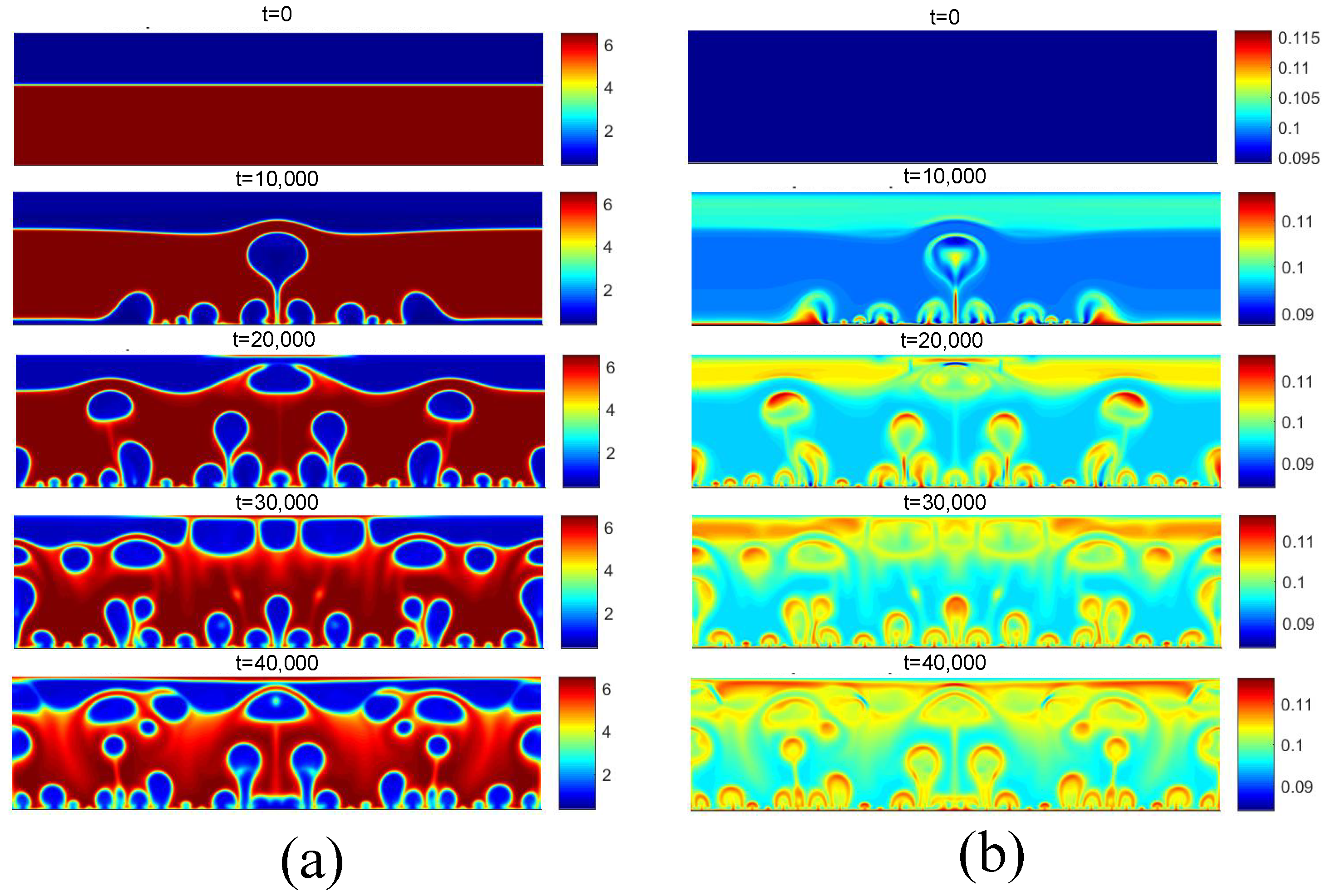
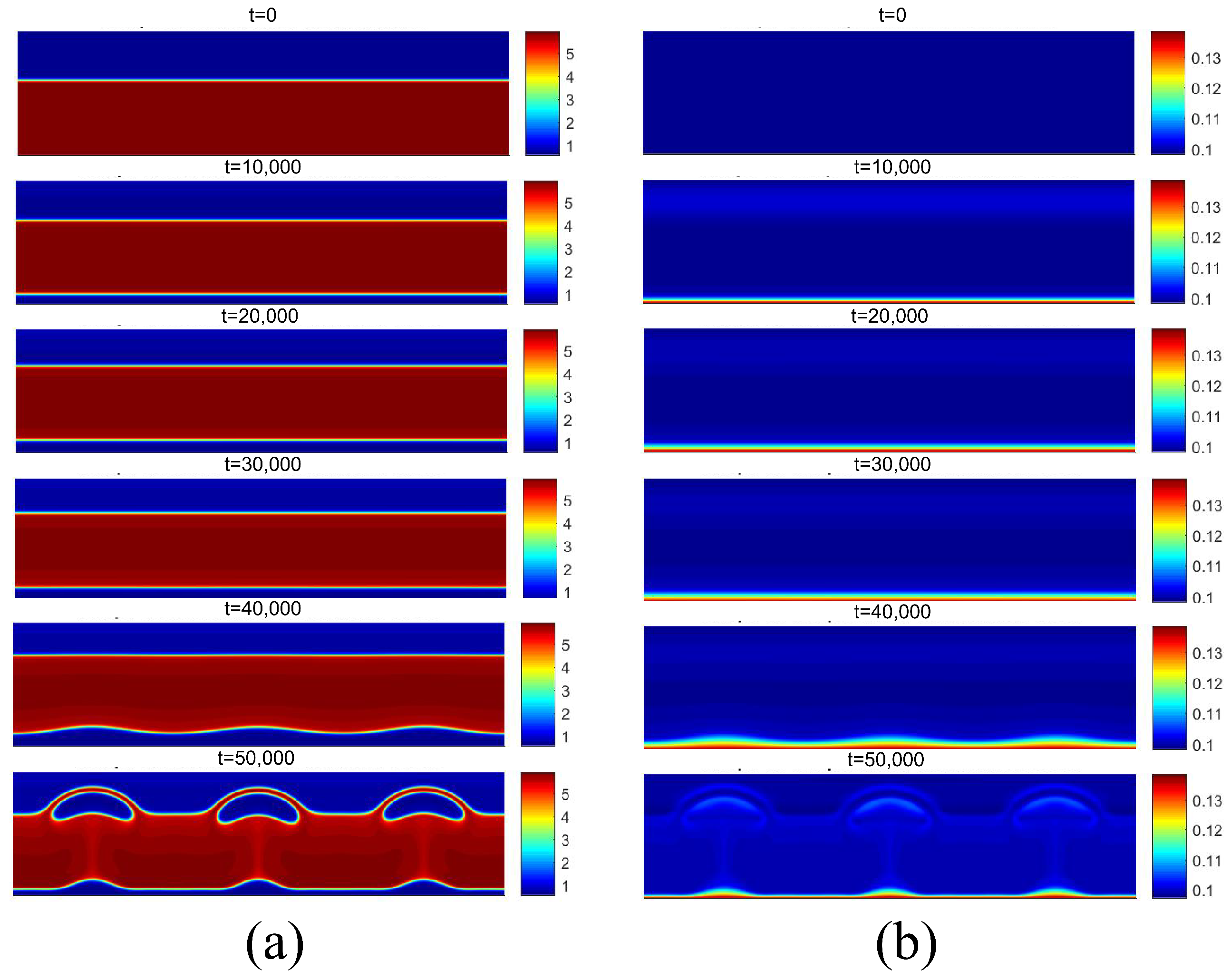





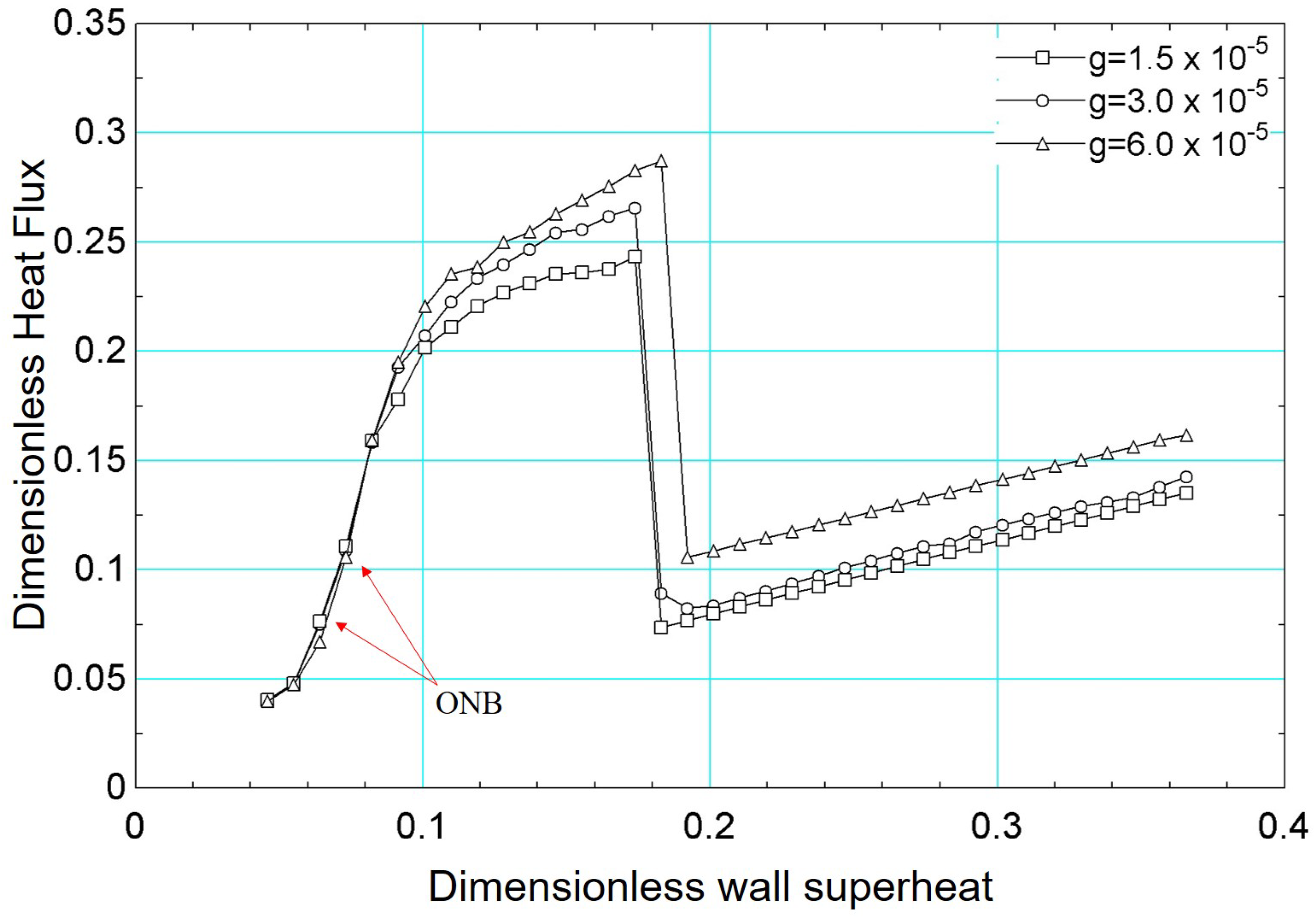
Disclaimer/Publisher’s Note: The statements, opinions and data contained in all publications are solely those of the individual author(s) and contributor(s) and not of MDPI and/or the editor(s). MDPI and/or the editor(s) disclaim responsibility for any injury to people or property resulting from any ideas, methods, instructions or products referred to in the content. |
© 2025 by the authors. Licensee MDPI, Basel, Switzerland. This article is an open access article distributed under the terms and conditions of the Creative Commons Attribution (CC BY) license (https://creativecommons.org/licenses/by/4.0/).
Share and Cite
Guzella, M.d.S.; Cabezas-Gómez, L. Pseudopotential Lattice Boltzmann Method Simulation of Boiling Heat Transfer at Different Reduced Temperatures. Fluids 2025, 10, 90. https://doi.org/10.3390/fluids10040090
Guzella MdS, Cabezas-Gómez L. Pseudopotential Lattice Boltzmann Method Simulation of Boiling Heat Transfer at Different Reduced Temperatures. Fluids. 2025; 10(4):90. https://doi.org/10.3390/fluids10040090
Chicago/Turabian StyleGuzella, Matheus dos Santos, and Luben Cabezas-Gómez. 2025. "Pseudopotential Lattice Boltzmann Method Simulation of Boiling Heat Transfer at Different Reduced Temperatures" Fluids 10, no. 4: 90. https://doi.org/10.3390/fluids10040090
APA StyleGuzella, M. d. S., & Cabezas-Gómez, L. (2025). Pseudopotential Lattice Boltzmann Method Simulation of Boiling Heat Transfer at Different Reduced Temperatures. Fluids, 10(4), 90. https://doi.org/10.3390/fluids10040090






